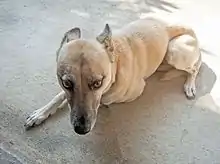Dog communication
Dog communication is the transfer of information between dogs, as well as between dogs and humans. Behaviors associated with dog communication are categorized into visual and vocal. Visual communication includes mouth shape and head position, licking and sniffing, ear and tail positioning, eye gaze, facial expression, and body posture. Dog vocalizations, or auditory communication, can include barks, growls, howls, whines and whimpers, screams, pants and sighs. Dogs also communicate via gustatory communication, utilizing scent and pheromones.
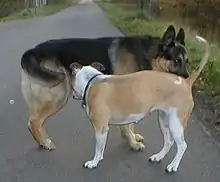
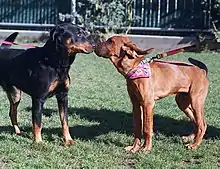
Humans can communicate with dogs through a wide variety of methods. Broadly, this includes vocalization, hand signals, body posture and touch. The two species also communicate visually: through domestication, dogs have become particularly adept at "reading" human facial expressions, and they are able to determine human emotional status. When communicating with a human their level of comprehension is generally comparable to a toddler. Humans can artificially alter how dogs communicate with other dogs and with humans by surgically cropping their ears and docking their tails. These procedures can have a strong impact on how dogs communicate and interact for the rest of their lives.
Dog–human communication
.jpg.webp)
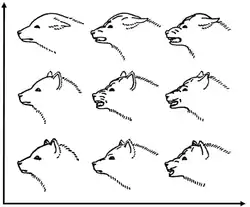
Both humans and dogs are characterized by complex social lives with rich communication systems, but it is also possible that dogs, perhaps because of their reliance on humans for food, have evolved specialized skills for recognizing and interpreting human social-communicative signals. Four basic hypotheses have been put forward to account for the findings.
- Dogs, by way of their interactions with humans, learn to be responsive to human social cues through basic conditioning processes.[2]
- By undergoing domestication, dogs not only reduced their fear of humans but also applied all-purpose problem-solving skills to their interactions with people. This largely innate gift for reading human social gestures was inadvertently selected for via domestication.[3][4]
- Dogs' co-evolution with humans equipped them with the cognitive machinery to not only respond to human social cues but to understand human mental states; a so-called theory of mind.[5][6]
- Dogs are adaptively predisposed to learn about human communicative gestures. In essence they come with a built-in "head start" to learn the significance of people's gestures, in much the same way that white-crowned sparrows acquire their species-typical song[7] and ducklings imprint on their own kind.[8]
Dogs tend to be highly responsive to human cues, especially the direction of a gaze and the direction in which a human points. Dogs rely on the gestures of humans more than verbal cues, most importantly eye contact. Eye contact is considered an ostensive cue, which dogs are very smart at understanding. "Ostensive cues are a characteristic element of human communicative interactions that express the sender’s intention to initiate a communicative interaction."[9] A human-dog gaze is one that strengthens the relationship between the two and it can create an ever stronger bond. It can help dogs establish stronger relationships by being able to communicate better with humans, as well as other dogs.[10] Dogs will start to act and react much like their owners do, as they begin to sync their behaviors to those of their owners. Dogs will pick up on how their owners respond towards strangers and nonfriendly dogs.[10]
The pointing gesture is a human-specific signal, is referential in its nature, and is a foundational building block of human communication. Human infants acquire it weeks before the first spoken word.[11] In 2009, a study compared the responses to a range of pointing gestures by dogs and human infants. The study showed little difference in the performance of 2-year-old children and dogs, while 3-year-old children's performances were higher. The results also showed that all subjects were able to generalize from their previous experience to respond to relatively novel pointing gestures. This can be explained as a joint outcome of their evolutionary history as well as their socialization in a human environment.[12]
One study has indicated that dogs are able to tell how big another dog is just by listening to its growl. The research also shows that dogs do not, or can not, misrepresent their size, and this is the first time research has shown animals can determine another's size by the sound it makes. The test, using images of many kinds of dogs, showed a small and big dog and played a growl. Twenty of the 24 test dogs looked at the image of the appropriately sized dog first and looked at it longest.[13]
Depending on the context, a dog's bark can vary in timing, pitch, and amplitude. It is possible that these have different meanings.[14]
Additionally, most people can tell from a bark whether a dog was alone or being approached by a stranger, playing or being aggressive,[15] and able to tell from a growl how big the dog is.[16] This is thought to be evidence of human-dog coevolution.[16]
Visual
Dogs communicating emotions through body positioning were illustrated in Charles Darwin's The Expression of the Emotions in Man and Animals published in 1872.
- Examples of body positioning to communicate different emotions in dogs.
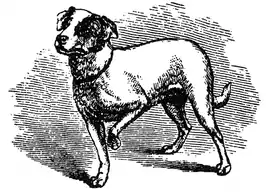 "Small dog watching a cat on a table"
"Small dog watching a cat on a table"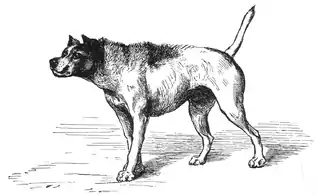 "Dog approaching another dog with hostile intentions"
"Dog approaching another dog with hostile intentions"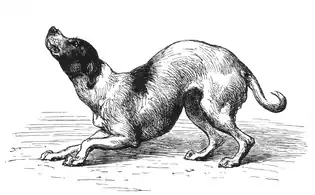 "Dog in a humble and affectionate frame of mind"
"Dog in a humble and affectionate frame of mind"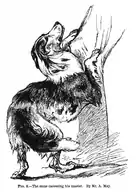 "Dog caressing his master"
"Dog caressing his master"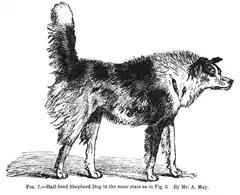 "Half-bred shepherd dog"
"Half-bred shepherd dog"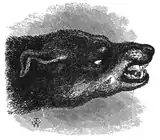 "Head of snarling dog"
"Head of snarling dog"
In her book On Talking Terms with Dogs,[17] Turid Rugaas identifies around 30 signals that she calls calming signals. The notion of dominance and submission is much debated.[18][19] In her book, she does not use these terms to differentiate behaviour. She describes calming signals as a way for dogs to calm themselves down or other humans/dogs around them. These are some of the signals she identifies:
- Licking/tongue flicks
- Sniffing the ground
- Turning away/turning of the head
- Play bow
- Walking slowly
- Freezing
- Sitting down
- Walking in a curve
- Yawning
- "Smiling"
- Wagging the tail
- Urinating
- Soft face
- Fiddling
- Lying down
- Play sneezing
By moving different parts of their bodies, whether facial expressions or postures, dogs can express a wide range of emotions and signals.
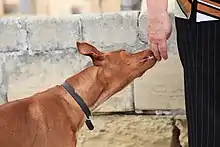
Mouth shape
- Mouth relaxed and slightly open; tongue perhaps slightly visible or draped over the lower teeth – this is the sign of a content and relaxed dog.[1]:114
- Mouth closed, no teeth or tongue visible. Usually associated with the dog looking in one direction, and the ears and head may lean slightly forward - shows attention, interest, or appraisal of a situation.[1]:115
- Curling or pulling the lips to expose the teeth and perhaps the gums - a warning signal. The other party has time to back down, leave, or show a pacifying gesture.[1]:116
- Mouth elongated as if pulled back, stretching out the mouth opening and showing the rear teeth - a submissive dog yielding to the dominant dog's threat.[1]:119
- "Smiling:" a calming signal.[17]
Head position
- A dominant or threatening dog that looks directly at another individual - a threat. It is pointing its weapons (muzzle/teeth).[1]:120
- A dominant dog turning its head away from a submissive dog - a calming action, indicating that it is not going to attack.[1]:120
- A less dominant dog approaching a dominant dog with its head down, and only on occasion quickly pointing its muzzle towards the higher-status dog - shows no fight is intended.[1]:120
- In an alternative interpretation that does not involve dominance and submission, turning the head away is recognized as a calming signal.[17]
Yawn
Similarly to humans, dogs yawn in an attempt to awaken. Dogs will also yawn when under stress, or as a pacifying signal when being menaced by aggression signals from another dog. Yawning, accompanied by a head turned away from the aggressor, can defuse a potentially threatening situation.[1]:120–122 It is also recognized as a calming signal.[17]
Licking and sniffing
Licking behavior has multiple causes and meanings and should not be simply interpreted as affection. Dogs that are familiar with each other may lick each other's faces in greeting, then sniff any moist membranes where odors are strongest (i.e. mouth, nose, anal region, or urogenital region.) Mating behaviors are characterized by licking in a more vigorous manner than used during greetings.[1]:124 Licking can communicate information about dominance, intentions, and state of mind, and like the yawn, is mainly a pacifying behavior. All pacifying behaviors contain elements of puppy behavior, including licking. Puppies lick themselves and their litter-mates as part of the cleaning process, and it appears to build bonds. Later in life, licking ceases to be a cleaning function and forms a ritualized gesture indicating friendliness.[1]:124–125 When stressed, a dog might lick the air, its own lips, or drop down and lick its paws or body.[1]:126Lip-licking and sniffing are also recognized as calming signals.[17]
Ears
Dogs' ears play an important role in communication between humans and other dogs. It is important to consider the breed of the dog and the ear morphology when determining the positioning of the ear. Ability to move their ears is different among each breed. In addition, some ears move very little if artificially altered or cropped by humans.[10]
- Ears erect or slightly forward - signals attention or alertness.[1]:130
- Ears pulled back flat against the head, teeth bared - signals an anxious dog that will defend itself.[1]:131
- Ears pulled back flat against the head, teeth not bared - signals submission.[1]:131
- Ears pulled slightly back and slightly splayed - signals indecision, or uneasy suspicion that may become aggression.[1]:131
- Ears flickering, slightly forward, then slightly back or downward - signals indecision with a submissive or fearful component.[1]:131
- Ears pulled close to the head to give a "round face" - a calming signal.[17]
- Ears pulled back in varying angles - expresses arousal.[10]
- Ears flattened or pressed down - indicates fear, anger, or frustration.[10]
- Ears pressed tightly to the head - expresses extreme fear.[10]
- Ears held sideways - indicates conflicting emotions due to an unsettling situation.[10]
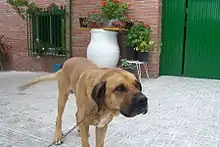
Eyes
Eyes can be very informative when it comes to communicating with other dogs or humans. When dogs want to threaten a perceived adversary, they will stare. In contrast, dogs will avoid eye contact if trying to decrease tension.[10]
They can communicate emotional states by having "soft" eyes or "hard" eyes. Soft eyes are used when a dog feels relaxed and not threatened. Hard eyes are used when feeling tension and unease about a potentially threatening situation. The eyes are slightly closed, the brow area is wrinkled, and their teeth may be showing. A dog should not be approached when they are communicating this way and should be removed from the high tension situation, if possible.[10]
Tail
- Tail held high - communicates confidence, arousal, and willingness to be approached by other dogs or humans
- Tail horizontal, pointing away from the dog but not stiff – signals attentiveness.[1]:162
- Tail horizontally straight out, stiff, and pointing away from the dog – displays an initial challenge that could lead to aggression if feeling threatened or anxious.[1]:162
- Tail up, between the horizontal and vertical position – conveys dominance .[1]:162
- Tail up and slightly curved over back – signals confidence; seen in a dominant dog that feels in control.[1]:163
- Tail held lower than horizontally but still some distance off from the legs, perhaps with an occasional swishing back and forth – an unconcerned, relaxed dog.[1]:166
- Tail down, near hind legs, legs straight, tail swings back and forth slowly – dog feeling unwell, slightly depressed or in moderate pain.[1]:166
- Tail down, near hind legs, hind legs bent inwards to lower the body – expresses timidity, apprehension, or insecurity.[1]:166
- Tail tucked between legs – expresses fear, anxiety, or nervousness; can also be a ritualized pacifying signal to fend off aggression from another dog.[1]:167
- Tail fast wagging – excitement.[1]:171
- Slight tail wag, each swing of only a small size – greeting.[1]:171
- Broad tail wag – friendly.[1]:172
- Broad tail wag, with wide swings that pull the hips from side to side – happy greeting.[1]:172
- Slow tail wag with tail at half-mast – unsure of what to do next, insecure.[1]:173
- Tail wagging is also recognized as a calming signal.[17]
- Tail wagging to the left side of the body - the dog senses a negative situation, such as unfamiliar dogs or people.[10]
- Tail wagging to the right side of the body - the dog feels comfortable and safe.[10]
.jpg.webp)
Dogs are said to exhibit a left-right asymmetry of the tail when interacting with strangers, and will show the opposite right-left motion with people and dogs they know.[20]
It is equally important to consider the breed and the morphology of the dog when determining what each tail position truly means. Ability to move their tails can be different among different breeds due to the fact that humans can dock their tails or remove them completely.[10] In addition, some breeds such as the Australian Stumpy Tail Cattle Dog are born with extremely short tails, or in other breeds, such as the Pembroke Welsh Corgi, may be born without a tail altogether.
Body
Dogs' bodies alone can communicate a lot. By increasing the size and tension of their bodies and making themselves look larger, they can communicate confidence, alertness, or even threat. Actions meant to reduce the size of the body, such as lowering to the floor with tail tucked and lowered ears, can communicate stress, fear, nerves, or a desire to avoid conflicts.[10]
- Stiff-legged, upright posture or slow, stiff-legged movement forward – dominant dog.[1]:184
- Body slightly sloped forward, feet braced – challenge to a dominant dog, conflict may follow.[1]:187
- Hair bristles on back of shoulders – possible aggression, may also indicate fear and uncertainty.[1]:187
- Lowering the body or cringing while looking up – submission.[1]:188
- Muzzle nudge – occurs when a submissive dog gently pushes the muzzle of the dominant dog, showing acceptance.[1]:190
- Dog sits when approached by another, allowing itself to be sniffed – signals acceptance of dominance but does not signal weakness.[1]:191
- Dog rolls on side or exposes underbelly and completely breaks off eye contact – extreme pacifying or submission signal.[1]:192
- Dog sits with one front paw slightly raised – stress, social fear and insecurity.[1]:198 It is also recognized as a calming signal.[17]
- Dog rolls on its back and rubs its shoulders on the ground – contentment.[1]:199
- Dog crouches with front legs extended, rear body and tail up, facing its playmate directly – classic "play-bow" to commence play.[1]:200 It is also recognized as a calming signal.[17]
Auditory
Long-distance contact calls are common in Canidae, typically in the form of either barks (termed "pulse trains") or howls (termed "long acoustic streams").[21][22] The long-distance howling of wolves[23] and coyotes[24][25][26] is one way in which dogs communicate.
By the age of four weeks, the dog has developed the majority of its vocalizations. The dog is the most vocal canid and is unique in its tendency to bark in a myriad of situations. Barking appears to have little more communication functions than excitement, fighting, the presence of a human, or simply because other dogs are barking. Subtler signs such as discreet bodily and facial movements, body odors, whines, yelps, and growls are the main sources of actual communication. The majority of these subtle communication techniques are employed at a close proximity to another, but for long-range communication only barking and howling are employed.[27]:Ch10
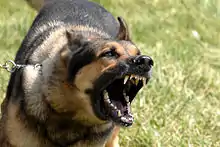
Barks
- Barking in rapid strings of 3 or 4 with pauses in between, midrange pitch – alerting call, the dog senses something but not yet defined as a threat.[1]:79
- Rapid barking, midrange pitch – basic alarm bark.[1]:79
- Barking still continuously but a bit slower and lower pitch – imminent threat, prepare to defend.[1]:80
- A prolonged string of barks, with moderate to long intervals between each one – lonely, in need of companionship, often exhibited when confined.[1]:80
- One or two sharp, short barks of high or midrange pitch – typical greeting sound, usually replaces the alarm bark when visitor is identified as friendly or the dog feels insecure.[1]:80
- Single sharp short bark, lower midrange pitch – annoyance, used by a mother dog disciplining her puppies or by a dog disturbed from its sleep.[1]:80
- Single short bark, higher midrange pitch – surprised or startled.[1]:81
- Stutter bark, midrange pitch – used to initiate play.[1]:82
- Rising bark – indicates having fun, used during play-fighting or when the owner is about to throw an object.[1]:83
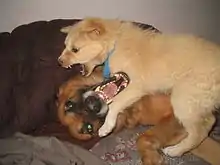
Growls
- Soft, low-pitched growling that seems to come from the chest – used as a threat by a dominant dog.[1]:83
- Soft growling that is not so low-pitched and seems more obviously to come from the mouth – stay away.[1]:83
- Low-pitched growl-bark – growl leading to a bark is both a threat and a call for assistance.[1]:84
- Higher midrange-pitched growl-bark – higher pitch means less confident, frightened but will defend itself.[1]:84
- Undulating growl, going from midrange to high midrange – dog is terrified, it will either defend itself or run away.[1]:84
- Noisy growl, medium and higher pitch, with teeth hidden from view – intense concentration, may be found during play-aggression, however you need to look at the whole body language to be sure.[1]:84
Howls
- Yip-howl – lonely, in need of companionship.[1]:86
- Howling – indicates the dog is present, or indicating that this is its territory.[1]:86
- Bark-howl, 2-3 barks followed by a mournful howl – dog is relatively isolated, locked away with no companionship, calling for company or a response from another dog.[1]:87
- Baying – can be heard during tracking to call pack-mates to the quarry.[1]:88
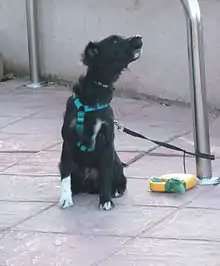
Whines and whimpers
Whining and whimpers are short, high pitched sounds designed to bring the listener closer to show either fear or submission on the behalf of the whiner or whimperer. These are also the sounds that puppies make as pacifying and soliciting sounds.[1]:89
- Soft whining and whimpering – hurting or scared.[1]:91
- Moan or moan-yodel, lower pitched than whines or whimpers – spontaneous pleasure or excitement.[1]:91
- Single yelp or high-pitched bark – response to sudden, unexpected pain such as a too-hard play bite.[1]:91
- Series of yelps – severe fear or pain.[1]:91
Screaming
A yelp for several seconds in length much like a human child, then repeated – anguish or agony, a call to the pack-mates for help, is rarely heard. It should also never be ignored, as it could be an indication of severe injury. If your dog screams, take it to the vet immediately[1]:92–93
Panting
Panting is an attempt to regulate body temperature. Excitement can raise the body temperature in both humans and dogs. Although not an intentional communication, if the dog pants rapidly but is not exposed to warm conditions then this signals excitement due to stress.[1]:95
Sighs
Sighs are an expression of emotion, usually when the dog is lying down with its head on its paws. When the eyes are half-closed, it signals pleasure and contentment. When the eyes are fully open, it signals displeasure or disappointment.[1]:96
Olfactory
Dogs have an olfactory sense 40 times more sensitive than a human's and they commence their lives operating almost exclusively on smell and touch.[1]:247 The special scents that dogs use for communication are called pheromones. Different hormones are secreted when a dog is angry, fearful or confident, and some chemical signatures identify the sex and age of the dog, and if a female is in the estrus cycle, pregnant or recently given birth. Many of the pheromone chemicals can be found dissolved in a dog's urine, and sniffing where another dog has urinated gives the dog a great deal of information about that dog.[1]:250 Male dogs prefer to mark vertical surfaces with urine and having the scent higher allows the air to carry it further.[30] The height of the marking tells other dogs about the size of the dog, as among canines size is an important factor in dominance.[1]:251 Dogs (and wolves) not only use urine but also their stools to mark their territories. The anal gland of canines give a particular signature to fecal deposits and identifies the marker as well as the place where the dung is left. A small degree of elevation may be sought, such as a rock or fallen branch, to aid scent dispersal. Scratching the ground after defecating is a visual sign pointing to the scent marking.[1]:253
References
- Coren, Stanley (2012). How To Speak Dog. New York: Simon and Schuster. ISBN 9781471109416.
- Udell, MA; Wynne, CD (March 2008). "A review of domestic dogs' (Canis familiaris) human-like behaviors: or why behavior analysts should stop worrying and love their dogs". Journal of the Experimental Analysis of Behavior. 89 (2): 247–61. doi:10.1901/jeab.2008.89-247. PMC 2251326. PMID 18422021.
- Hare, Brian (23 June 2016). "From nonhuman to human mind. What changed and why?". Current Directions in Psychological Science. 16 (2): 60–64. doi:10.1111/j.1467-8721.2007.00476.x. S2CID 3402472.
- Hare, Brian; Tomasello, Michael (2005). "Human-like social skills in dogs?". Trends in Cognitive Sciences. 9 (9): 439–44. doi:10.1016/j.tics.2005.07.003. PMID 16061417. S2CID 9311402.
- Miklósi, A'.; Polgárdi, R.; Topál, J.; Csányi, V. (1 December 2000). "Intentional behaviour in dog-human communication: an experimental analysis of "showing" behaviour in the dog". Animal Cognition. 3 (3): 159–166. doi:10.1007/s100710000072. S2CID 18448656.
- Miklósi, Á.; Topál, J.; Csányi, V. (June 2004). "Comparative social cognition: what can dogs teach us?". Animal Behaviour. 67 (6): 995–1004. doi:10.1016/j.anbehav.2003.10.008. S2CID 15248027.
- Marler, Peter (1970). "A comparative approach to vocal learning: Song development in white-crowned sparrows". Journal of Comparative and Physiological Psychology. 71 (2, Pt.2): 1–25. doi:10.1037/h0029144.
- Lorenz, Konrad (1965). Evolution and modification of behavior. University of Chicago Press.
- Kaminski, Juliane (2014). The Social Dog. Academic Press. p. 329. ISBN 9780124078185.
- Siniscalchi, Marcello; d’Ingeo, Serenella; Minunno, Michele; Quaranta, Angelo (31 July 2018). "Communication in Dogs". Animals. 8 (8): 131. doi:10.3390/ani8080131. ISSN 2076-2615. PMC 6116041. PMID 30065156.
- Butterworth, George (2003). "Pointing is the royal road to language for babies". Cite journal requires
|journal=(help) - Lakatos, Gabriella (2009). "A comparative approach to dogs' (Canis familiaris) and human infants' comprehension of various forms of pointing gestures". Animal Cognition. 12 (4): 621–31. doi:10.1007/s10071-009-0221-4. PMID 19343382. S2CID 18078591.
- Faragó, T; Pongrácz P; Miklósi Á; Huber L; Virányi Z; Range, F (2010). Giurfa, Martin (ed.). "Dogs' Expectation about Signalers' Body Size by Virtue of Their Growls". PLOS ONE. 5 (12): e15175. Bibcode:2010PLoSO...515175F. doi:10.1371/journal.pone.0015175. PMC 3002277. PMID 21179521.
- "What dogs are saying Scientific American". Retrieved 9 August 2015.
- Brian Hare; Vanessa Woods (8 February 2013), "What Are Dogs Saying When They Bark? [Excerpt]", Scientific America, retrieved 17 March 2015
- Katherine Sanderson (23 May 2008), "Humans can judge a dog by its growl", Nature, doi:10.1038/news.2008.852 research available here
- Rugaas, Turid (2006). On talking terms with dogs : calming signals (2nd ed.). Wenatchee, Wash.: Dogwise Pub. ISBN 1929242360.
- Eatron, Barry. Dominance in dogs: Fact or Fiction. Dogwise Publishing. ASIN B011T6R50G.
- Rousseau, Steph. "Digging the dirt on dominance". Pet Dog Trainers of Europe Blog.
- "Asymmetric tail-wagging responses by dogs to different emotive stimuli", Current Biology, 17(6), 20 March 2007, pp R199-R201
- Robert L. Robbins, "Vocal Communication in Free-Ranging African Wild Dogs", Behavior, vol. 137, No. 10 (Oct. 2000), pp. 1271-1298.
- J.A. Cohen and M.W. Fox, "Vocalizations in Wild Canids and Possible Effects of Domestication," Behavioural Processes, vol. 1 (1976), pp. 77-92.
- John B. Theberge and J. Bruce Falls, "Howling as a Means of Communication in Timber Wolves," American Zoologist, vol. 7, no. 2 (May 1967), pp. 331-338.
- P.N. Lehner, "Coyote vocalizations: a lexicon and comparisons with other canids," Animal Behavior, vol. 26 (1978) pp. 712-722.
- H. McCarley, "Long distance vocalization of coyotes (Canis latrans)," J. Mammal., vol. 56 (1975), pp. 847-856.
- Charles Fergus, "Probing Question: Why do coyotes howl?" Penn State News (15 January 2007).
- Fox, Michael W. (1971). Behaviour of Wolves, Dogs, and Related Canids (1st United States ed.). New York: Harper & Row. pp. 183–206. ISBN 0-89874-686-8.
- Rugaas, Turid (December 2005). On talking terms with dogs : calming signals (Second ed.). Wenatchee, Wash. ISBN 1-929242-36-0. OCLC 63519566.
- Eldredge, Debra (14 March 2019). "Why Do Dogs Sneeze When They're Excited?". Dogster. Retrieved 22 November 2020.
- L. David Mech; Luigi Boitani (1 October 2010). Wolves: Behavior, Ecology, and Conservation. University of Chicago Press. pp. 84–. ISBN 978-0-226-51698-1.

